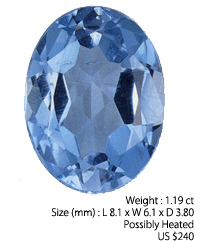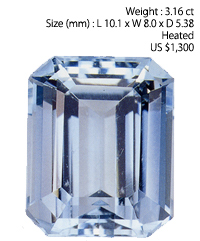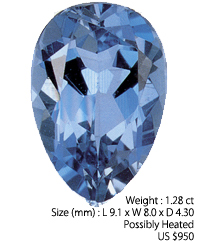CHARACTERISTICS BY COUNTRY OF ORIGIN
In the early 19th century, fine-quality rough aquamarine was mined in the state of Minas Gerais in Brazil and in the Ural region of Russia. Among the largest recorded is a 110-kilogram (242-pound) aquamarine discovered in 1910. Current major producers are Brazil, Nigeria, Zambia, Mozambique, and Madagascar. Of these, most Brazilian material is polished locally and exported, while rough from other producers is sent to Germany, India, and Thailand to be processed.
|
 |
Nigeria
Nigeria is a new source, having produced since 1983. There is quite a range in transparency and size of the material mined, but the majority is rough that can be fashioned into slightly dark, high-quality stones of 1 to 2 carats. Although aquamarine is a gemstone that is relatively free of imperfections, the Nigerian material tends to be more included than the Brazilian stones. Because these inclusions may cause fractures to develop when the stone is heated, Nigerian aquamarine is characteristically seen in its natural state, without undergoing heat treatment.
|
|
Brazil
Aquamarine has a reputation of coming from Brazil. It is true that larger stones often come from Brazil, with slightly light yet pure color and few imperfections. The majority of Brazilian aquamarine is heated to remove a slight greenish color, resulting in a purer, more beautiful blue color. This color will not change. Brazilian material is characteristically cut to tale advantage of the shape of the rough, and fancy shapes are often seen.
|
 |
 |
Mozambique
Mozambique is the newest source of aquamarine, with mining beginning in 1991. The Santa Maria mine in Minas Gerais of Brazil had formerly produced an extremely high-quality aquamarine of a deep blue color. The Mozambique material has been named “Santa Maria Africana” after this famous mine, and it is synonymous with rich-colored, high-quality aquamarine. At times the color can be too deep, making it overly gray and less attractive. |
|
 |
JUDGING QUALITY
The quality scale is a yardstick for representing the quality of gemstones, showing the tone (lightness to darkness) of color and beauty grade.
The quality of aquamarine is based on a beautiful blue appearance with an appropriate tone. A tone of 4 to 3 with a beauty grade of S or A is considered gem quality, neighboring grades are considered jewelry quality, and a tone of less than 1 with a beauty grade of C or D is classified as accessory quality. Stones with poor overall appearance, a grayish or greenish blue color, or eye-visible imperfections are considered accessory quality. Low-quality rough material is often cut into cabochons. with a beauty grade of C or D is classified as accessory quality. Stones with poor overall appearance, a grayish or greenish blue color, or eye-visible imperfections are considered accessory quality. Low-quality rough material is often cut into cabochons.
Aquamarines with tones of greater than 4 are rare. Although darker aquamarines are generally considered higher quality, they are often grayish and therefore lack beauty. Even with a deep-colored stone, the beauty grade will drop if a strong gray is present.
What at first may see, to be a simple aquamarine blue can be separated into over 100 categories when one considers tone, beauty grade, and country of origin. As with other bluish gemstones, the color of aquamarine is most easily judged when viewed under fluorescent lighting.
|
|